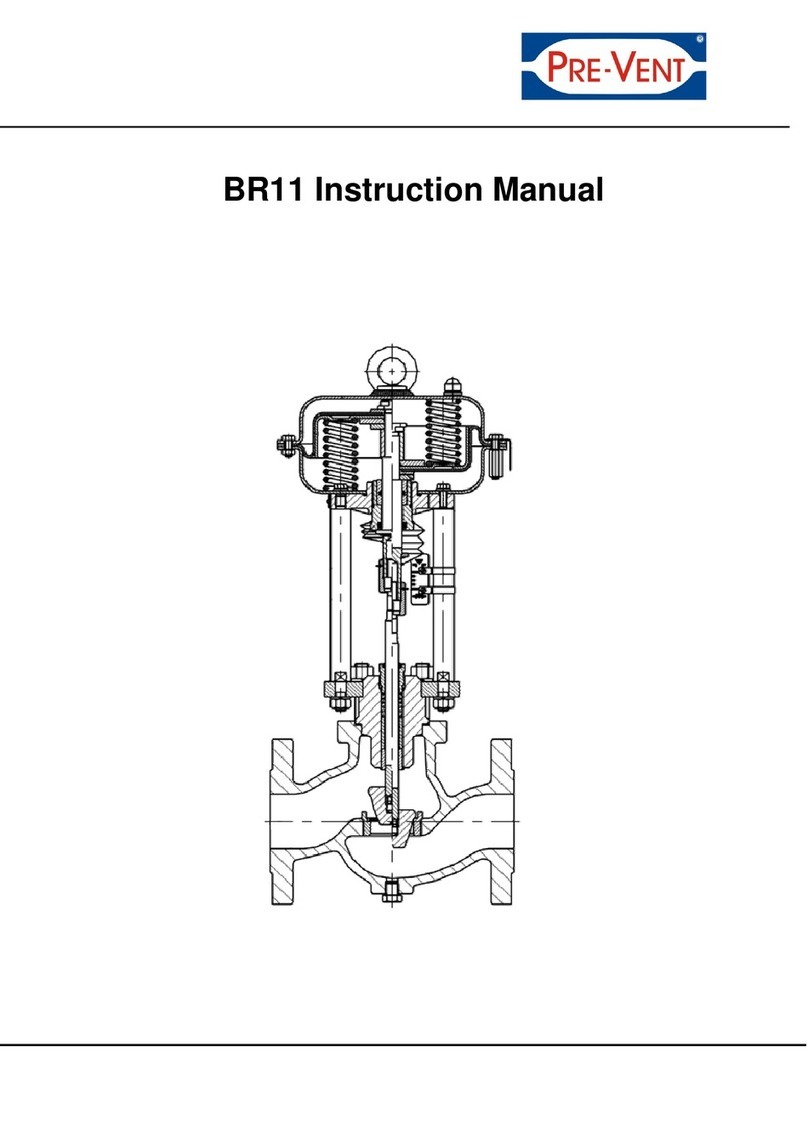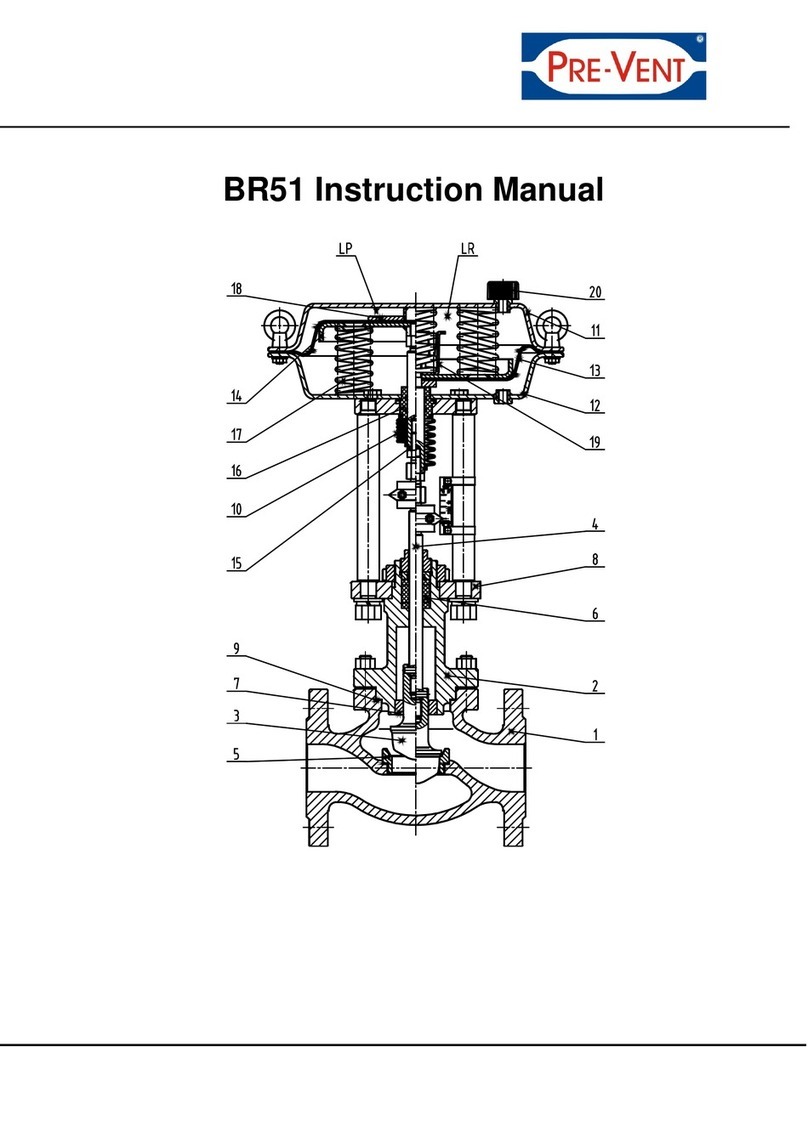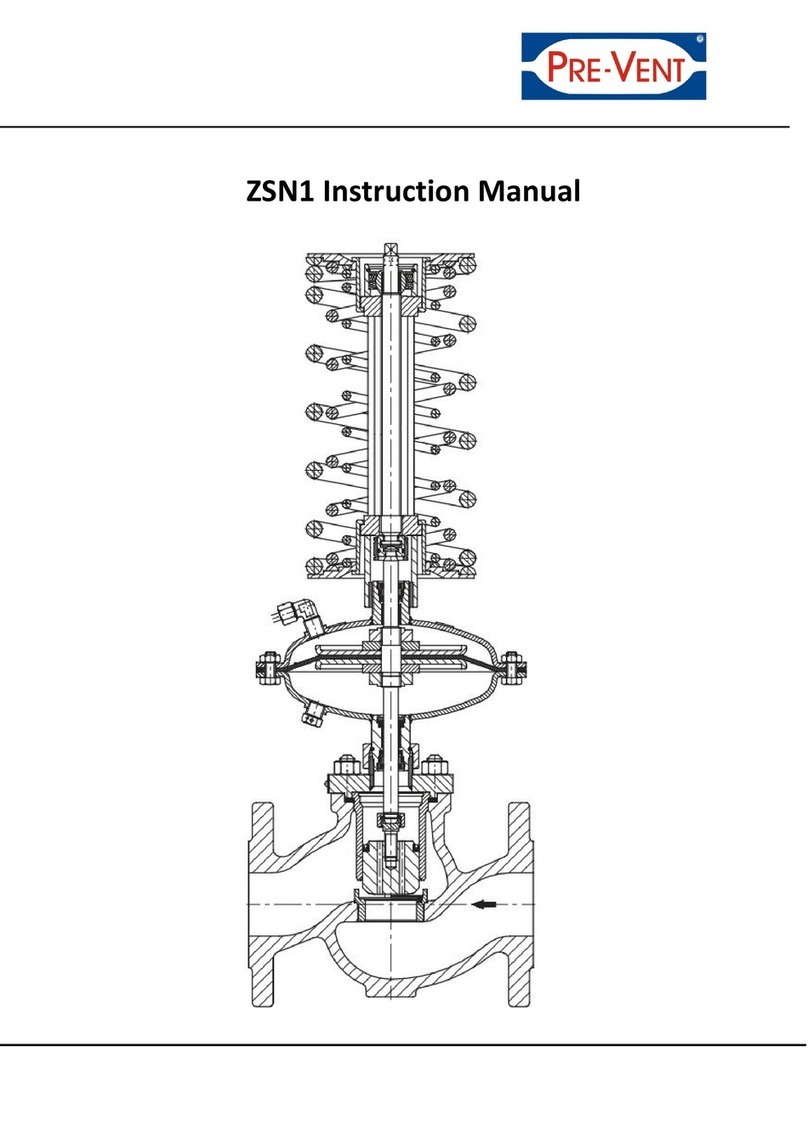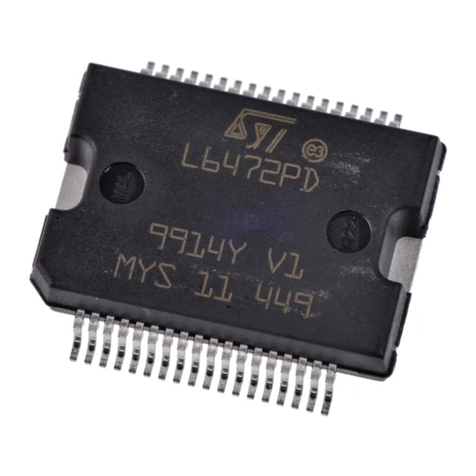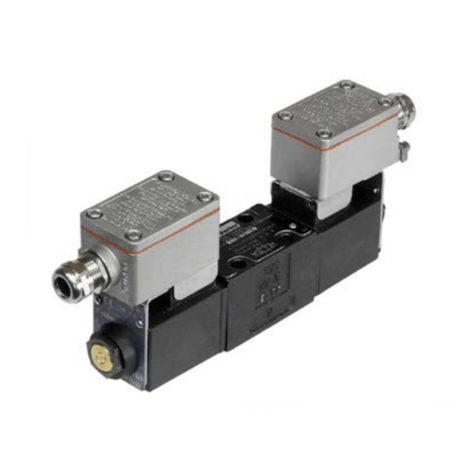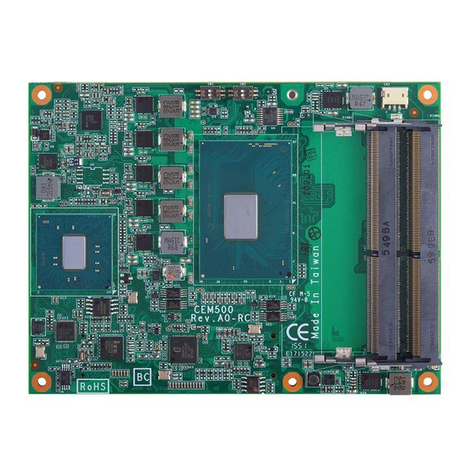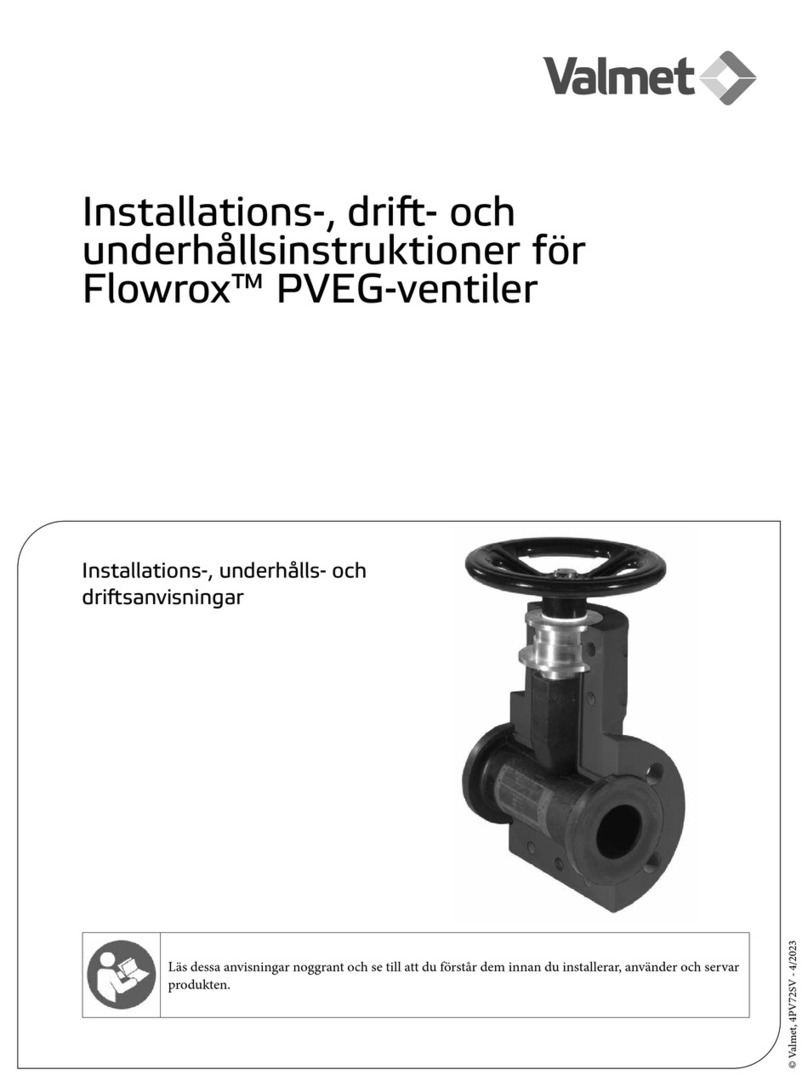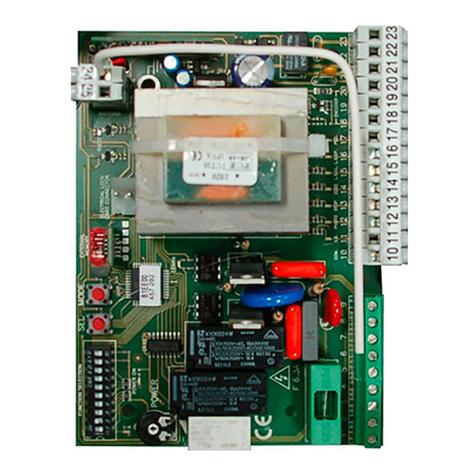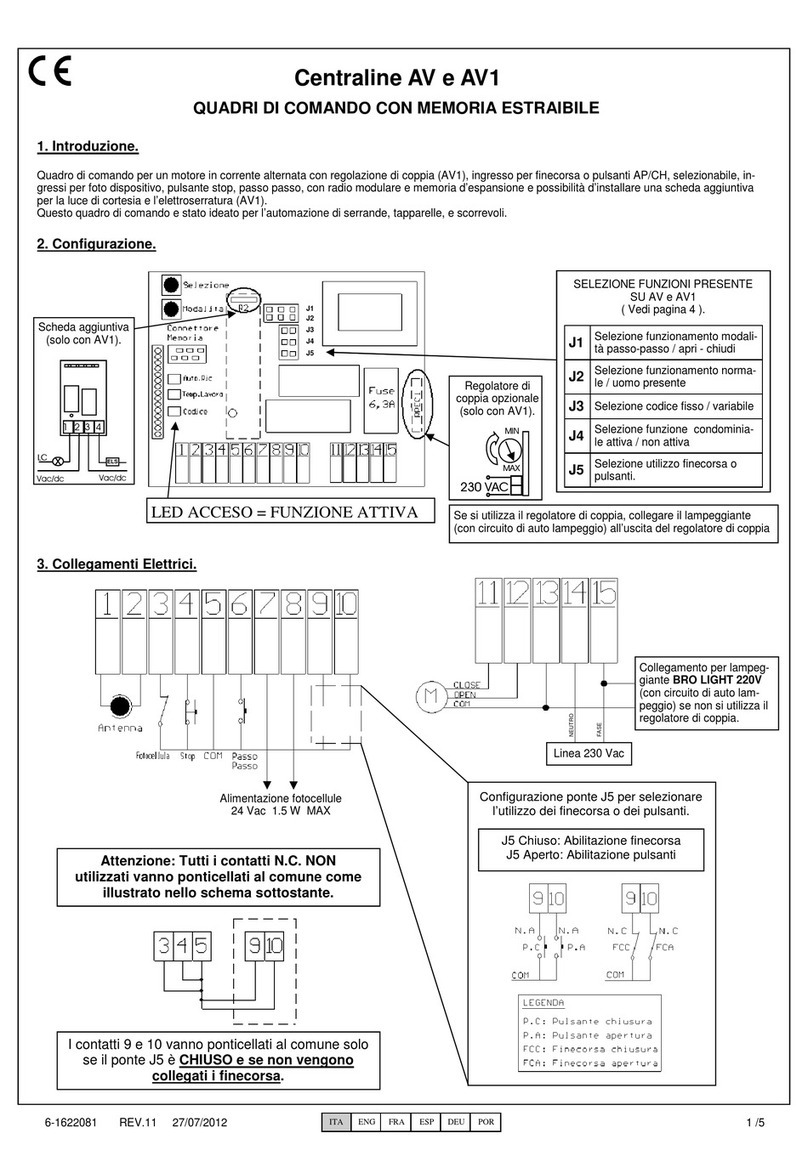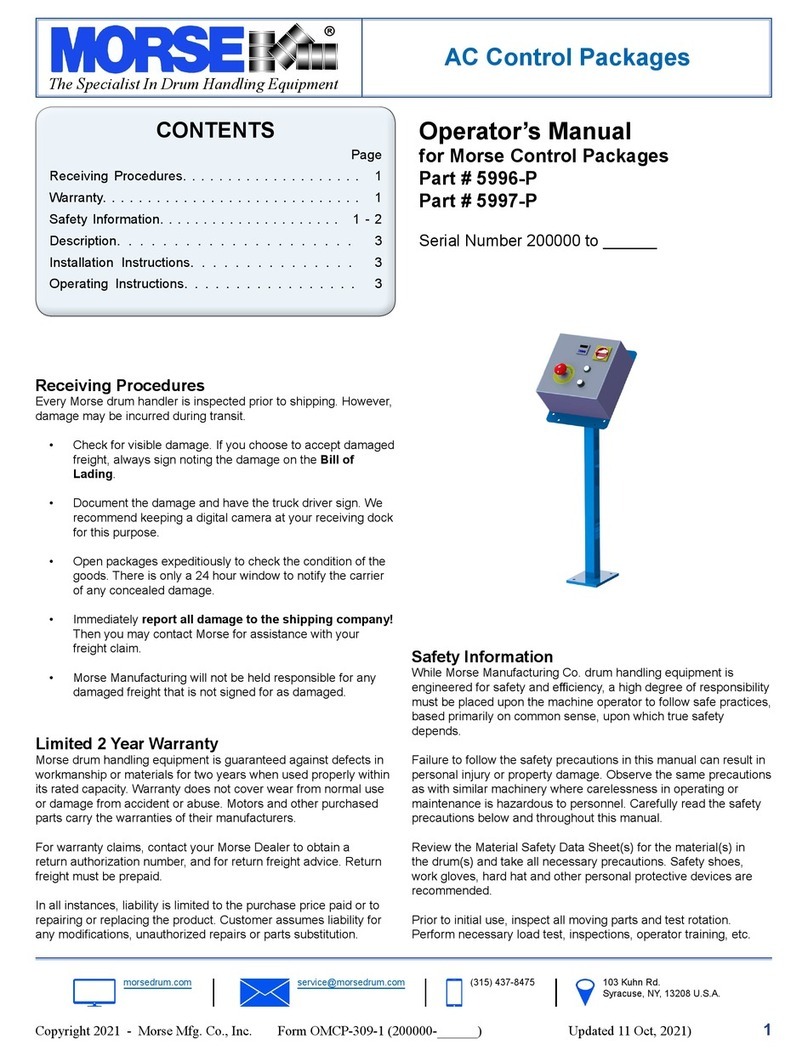preVent BR13 User manual

BR13 Instruction Manual

2
Manual BR13 Version 1.2 07.11.2019
Contents:
Page
Introduction 2
1.
Functional principle
3
2.
Installation
3
3.
Operating conditions
3
4.
Operability, maintenance and repair
3
-
standard construction
4.1.
gland packing
3
4.2. valve seat and plug 4
5.
Model with pneumatic P/R drive
5
5.1.
Changing the operating mode of the drive
6
5.2.
Replacing a membrane
6
6..
Other drives
6
7.
Diagrams / Spare parts lists
7
8.
Contacting us
12
To ensure trouble-free and safe operation of the valve, it is essential to be familiar with the contents of this BR13 Instruction
Manual, and also with the general instructions for installation and operation, before installing and operating the valve.
Failure to observe or comply with these operating instructions will invalidate the manufacturer’s guarantee and liability. The
manufacturer’s general conditions of sales and terms of delivery shall apply unless otherwise stated.

3
Manual BR13 Version 1.2 07.11.2019
1. FUNCTIONAL PRINCIPLE
The valve regulates mass-flow by a linear movement of the valve spindle, which may be operated pneumatically, electrically
or manually. As the stroke of the valve alters, the circular gap between the valve seat and the valve block is increased or
reduced. This directly influences the amount of fluid flowing through the valve.
2. INSTALLATION
The valve may be mounted in any position; however, for valves of DN 80 size and above, vertical installation with the drive
mounted above is preferred. For valves with extended construction, bellows, or drives weighing more than 50 kg, a suitable
support or suspension mounting should be provided for the drive, otherwise its own weight might cause wear and leakage at
the seals.
3. OPERATING CONDITIONS
Regulator valves should be operated under conditions that take into account the size and nature of the construction and the
type of material. To ensure trouble-free operation over the whole operational lifetime, the regulator valve and its accessories
should be regularly inspected and maintained.
Normal operating conditions:
a) With pneumatic positioning drive
Ambient temperature from - 25 to + 80°C, with silicone diaphragm of -40 °C to +80 °C
Relative humidity up to 98 %,
The control and feed air supplies must contain no mechanical impurities, oil or corrosive substances, copper or
aluminium alloys, and must be dehumidified such that the dew-point corresponds to a temperature that is at least
10 °C lower than the operating temperature of the position controller and the positioning drive.
b) With electrical positioning drive
In accordance with the manufacturer’s instructions.
c) With hand-operated drives of type NN
Ambient temperature from - 25 to + 80°C
Relative humidity up to 98 %.
4. OPERABILITY, MAINTENANCE AND REPAIR - STANDARD CONSTRUCTION
The operability of the regulator valve during use is based on maintaining an appropriate flow characteristic and not
exceeding the permitted leakage level for the valve.
To ensure long-term correct and safe operation of the valve, it is essential to carry out regular recorded inspections. Valves
that operate continuously should be checked at least every 6 months. Valves that operate discontinuously should be
checked at least every 12 months.
If it is necessary to carry out maintenance or repair work on the regulator valve, it should be carried out as follows:
4.1. Gland packing
A key criterion for operability is external seal-tightness, which is provided by the gland packing.
The gland packing to be used is normally pre-specified based on the operating conditions.
With normal gland packing, the tightness of the seal is achieved by tightening the sealing nut.
WARNING:
When the valve is supplied, the sealing nut is only hand-tightened. Before putting the valve into service, it is
essential to tighten the sealing sufficiently to achieve an adequate contact pressure, thus ensuring a secure
external seal, but without blocking the valve spindle.
If self-adjusting sealing glands are used, the constant contact pressure is provided by a stainless steel spring. For this
reason, the sealing nut should be screwed in up to the stop.

4
Manual BR13 Version 1.2 07.11.2019
To change the gland packing, proceed as follows:
Before changing the gland packing, ensure that the valve is not under pressure and is not contaminated.
1. Disconnect the connection between valve and drive. in valves with air-operated or hand-operated actuators, by undoing
connecting nut (32) after loosening low (counter) nut (34)
2. undo nut (13) fastening actuator or hand-operation and disconnect it from the valve
3. undo and remove from valve stem the interlocking nut (33) and the connecting nut (32)
4. Loosen sealing packings in the packing-chamber by loosen the nut (11) on the threaded bolts (10), the packing gland
(12) or the gland plate (18) by the TA Luft version.
5. Loosen the nut (11) at the 3-way-bottom-flange (10) and remove the flange essay and the body gasket .
6. remove fitted seat (4.2)
7. pull out head and stem (5) set from packing-chamber of the valve body and remove it
8. loosen the nut (11) the packing gland (12) or packing plate (18) and packing gland or plate
9. Remove the pilot sleeve (14) and the packing (8,15) with suitable tools and clean the packing chamber.
10. Put in the stem (5) with plug into the valve
11. Install carfully the new packing. Observe the correct placement. (in reversed order as removed)
12. Install the pilot sleeve (14) and tight it.
13. Install fitted seat (4.2) new gasket (7) and the flange essay (2) and tight it about the nuts (11).
14. Interlocking nut (33) and connecting nut (32) back on to the stem.
15. Replace caferully the drive and connect him in reverse order as by disassembling
4.2. Replacement of the valve seat and the valve plug
If it is necessary to change the valve seat and valve block due to a change in the operating conditions or due to wear and
tear, proceed as follows:
Before making the change, ensure that the valve is not under pressure and is not contaminated.
In order to achieve a better seal when changing the valve seat and valve block, we recommend lapping the seat and the
block with a fine abrasive paste.
Replacing the double plug
1. Disassembling the valve as described in point 4.1 (changing packing gland) (point 1 until 7).
2. Knock out the pin (17) and unscrew the plug, screw in a new plug, redrill and put in the pin. Please check that the
stem has no grooves or other damages.
3. Install the stem (5) with plug into the valve.
4. Tight with the nuts (11) the packing gland or gland plate that the stuffing box seals.
5. Install fitted seat (4.2) new gasket (7) and the flange essay (2) and tight it about the nuts (11).
6. Interlocking nut (33) and connecting nut (32) back on to the stem
7. Replace carefully the drive and connect him in reverse order as by disassembling
Replacing fitted seat (4.2)
1. Disconnect the connection between valve and drive. in valves with air-operated or hand-operated actuators, by
undoing connecting nut (32) after loosening low (counter) nut (34)
2. Undo nut (13) fastening actuator or hand-operation and disconnect it from the valve
3. Undo and remove from valve stem the interlocking nut (33) and the connecting nut (32)
4. Loosen sealing packings in the packing-chamber by loosen the nut (11) on the threaded bolts (10), the packing
gland (12) or the gland plate (18) by the TA Luft version.

5
Manual BR13 Version 1.2 07.11.2019
5. Loose the nut (11) at the 3-way-bottom-flange (10) and remove the flange essay and the body gasket.
6. remove fitted seat (4.2)
7. Install new fitted seat (4.2) new gasket (7) and the flange essay (2) and tight it about the nuts (11).
8. Tight with the nuts (11) the packing gland or gland plate that the stuffing box seals.
9. Interlocking nut (33) and connecting nut (32) back on to the stem
10. Replace carefully the drive and connect him in reverse order as by disassembling
Replacing screwed in seat (4.1)
1. Disassembling the valve as described in „replacing fitted seat (4.2) “. Point 1 until 6
2. Remove stem with double plug from the body
3. Screw out anticlockwise the seat (4.1) with suitable seat-tool
4. Clean the new seat or repaired seat, grease them with mounting paste and screw in.
5. Install the stem (5) with plug into the valve.
6. Tight with the nuts (11) the packing gland or gland plate that the stuffing box seals
7. Install fitted seat (4.2) new gasket (7) and the flange essay (2) and tight it about the nuts (11).
8. Interlocking nut (33) and connecting nut (32) back on to the stem
9. Replace carefully the drive and connect him in reverse order as by disassembling
5. PNEUMATIC P/R DRIVE
When the pressure rises in the drive pressure chamber, a force is applied to the membrane in the drive unit. If this force
exceeds the spring force of the springs in the second chamber, the springs are compressed and the drive spindle starts to
travel out or in, according to the function. If the pressure continues to increase, once the maximum spring force is reached
the springs will be pressed against the end-stop and the drive will halt. Thus, a simple pneumatic drive can reach a defined
position in proportion to the air pressure.
The size of the drive is based on the cm
2
surface of the membrane.
Drive
size
Stroke
[mm]
Spring range (kPa)
1 2 3 4 5 6 7
20 - 100 40 - 200 40 - 120 0 - 240 60 - 140 120 - 2 0 1 0 - 3 0
No. of
springs
Total
tenstion
[mm]
No. of
springs
Total
tenstion
[mm]
No. of
springs
Total
tenstion
[mm]
No. of
springs
Total
tenstion
[mm]
No. of
springs
Total tenstion
[mm]
No. of
springs
Total tenstion
[mm]
No. of
springs
Total
tenstion
[mm]
250 20 3 - 6 - 3 - 6 - 3 6 6 6 - -
400 20 3 - 6 - 3 - 6 - 3 6 6 6 - -
630 3 3 - 6 - 3 10 6 10 3 10 + 10 6 10 + 10 12 10 + 10
1000
3 3 - 6 - 3 9,5 6 9,5 3 9,5 + 9,5 6 9,5 + 9,5 12 9,5 + 9,5
50 3 - 6 - 3 12,5 6 12,5 3 12,5 + 12,5 6 12,5 + 12,5 12 12,5 +
12,5
63 3 - 6 - 3 16 6 16 3 16 + 16 6 16 + 16 12 16 + 16
Spring range and drive sizes for pneumatic drives of type P/R
P type drive: Single membrane drive.
Safe position NO (open on loss of pressure)
When pressure rises in the upper chamber, the drive spindle travels out.
R type drive: Single membrane drive.
Safe position NC (closed on loss of pressure)
When pressure rises in the lower chamber, the drive spindle travels in.

6
Manual BR13 Version 1.2 07.11.2019
5.1 Changing the operating mode of the drive
No additional components are required in order to alter the direction of operation of type P/R pneumatic drives.
Changing P to R and vice versa
1. Disconnect the valve from the drive.
2. Ensure that no air pressure is applied to the drive.
3. Remove the top cover of the position drive, taking care that the tensioning nuts (long nuts) (82) are unscrewed to
the ends – in accordance with the notes on the warning label.
The further steps in the procedure depend on the current operating mode of the drive before it is changed.
To change the drive function from P to R, proceed as follows:
4. Undo the special nuts (34) from the bolts on the positioning drive.
5. Remove the membrane with its membrane plate, spacer ring, washer and spacer cover (or spacer covers for drive
sizes 630 and 1000).
6. Remove the springs (31) from the lower casing.
7. Turn the membrane together with all the parts as listed above through 180 degrees, and fit the membrane back
over the drive bolts.
8. Screw the special nuts (34) on to the drive bolts, thus compressing the whole of the above group of components.
9. Place the springs on the membrane plate so that they fit in the guide cut-outs and their ends are aligned with the
axis of the bolts.
10. Place the top cover over the springs and initially tighten the tensioning nuts (82).
11. Compress the springs evenly until the upper part of the drive end-stop is pressed against the lower part, then insert
the rest of the bolts and screw on the nuts.
To change the drive function from R to P, proceed as follows:
4. Remove the springs (31) from the membrane plate (28).
5. Undo the special nuts (34) from the bolts on the positioning drive.
6. Remove the membrane with its membrane plate, spacer ring, washer and spacer cover (or spacer covers for drive
sizes 630 and 1000).
7. Place the springs in the designated locations in the lower cover.
8. Turn the membrane together with all the parts as listed above through 180 degrees, and fit the membrane back
over the drive bolts, so that the 6 mm diameter opening on the base and the nut on the edge of the drive membrane
plate are axially aligned with one of the openings on the edge of the membrane.
9. Screw the special nuts (34) on to the drive bolts, thus compressing the whole of the above group of components.
10. Place the springs on the membrane plate (28) so that they fit in the guide cut-outs. To check that the springs are in
the correct position, rotate the membrane (to the position of the notch on the nut at the edge of the membrane
plate) until the 6 mm opening on the base is visible. By sighting through the opening, check that there is a spring in
place on the underside.
11. Place the top cover over the springs and initially tighten the tensioning nuts (82).
12. Compress the springs evenly until the upper part of the drive end-stop is pressed against the lower part, then insert
the rest of the bolts and screw on the nuts.
5.2 Changing the membrane
Should it be necessary to change a membrane, the drive should be dismantled as described in item 6.1. Instead of putting
the drive back together in reverse order, it should simply be re-assembled in its original order after changing the membrane.
6. Other Drives
It is possible to equip model BR13 valves with electrical drives. Sizing the drive to the regulator valve is normally a part of
the bidding process.
It is also possible to supply model BR13 valves with a purely manual operation (type NN), or to fit the pneumatic drive with
an additional hand-wheel (type P/R-N).
(See the following diagrams)

7
Manual BR13 Version 1.2 07.11.2019
7. DRAWINGS / SPARE PARTS LISTS
Figure 1a
valve BR13 with standard
stuffing box
Figure 1b
Valve BR13 with
TA-Luft stuffing box

8
Manual BR13 Version 1.2 07.11.2019
Figure 2a
Valve BR13 with pneu atic drive P/R

9
Manual BR13 Version 1.2 07.11.2019
Figure 2b
Valve BR13 with pneu atic drive
PN/RN

10
Manual BR13 Version 1.2 07.11.2019
Figure 3a
Handwheel Typ 20
Figure 3b
Valve BR13 with electric drive

11
Manual BR13 Version 1.2 07.11.2019
Part name
Part name
1
Body
54
O
-
Ring
2
lange essay
(3
–
way
-
flange
)
55
O
-
Ring
3
plug
56
O
-
Ring
4.1
Screwed in seat
57
O
-
Ring
4.2
itted seat
58
snap
ring
5
stem
59
Top housing (set)
6
Guiding
sleeve
60
Drive bolt
7
Body gasket
61
Driver
8
Stuffing box
62
holder
9
spring
63
Drive wheel
10
Bolt
64
Special bolt
11
Nut
65
washer
12
Packing gland
66
washer
13
astening nut
67
Thrust bearing
14
Pilot sleeve
68
bolt
15
Spacing
sleeve
69
washer
16
Nut (low)
70
O
-
Ring
17
Pin
71
O
-
Ring
18
Gland plate
72
Snap ring Z
19
Nameplate
73
Connector
20
Rivet pin 3x6
74
21
Column
75
Warning plate
22
Bracket
76
turnbuckle
23
Bottom housing
77
Stem casing
24
Top housing
(set)
78
O
-
Ring
25
Diaphragm plate
79
Drive yoke
26
diaphragm
80
Drive wheel
27
Spacing ring
81
Drive sleeve
28
spring
82
Drive cap
29
Packing
-
box set
83
Drive stem
30
Actuator stem
84
key
31
Special nut
85
Stroke plate
32
Connecting nut
86
Ball bearing
33
Interlocking nut
87
Grease nipple
34
Low (counter) nut
88
indicator
35
Position indicator
89
Pin with notches
36
Column clamping ring
90
screw
37
Stroke plate
91
Connecting plate
38
washer
39
washer
40
Spacing sleeve
41
Stopper ring
42
Venting pin
43
Actuator nameplate
44
Bolt
45
bolt
46
bolt
47
screw
M4x8
48
nut
M4
-
A
49
Nut
50
nut
51
Spring washer
52
Washing ring
53
Scraping ring

12
Manual BR13 Version 1.2 07.11.2019
PRE-VENT GmbH
Sales - Production - Service
Piracher Straße 74
84489 Burghausen, Germany
fon +49 8677 98788-0
fax +49 8677 98788-80
Email:
Web: www.pre-vent.com
Manual version 1.2 07.11.2019
9. Contacting us
Details / specific information (Operating instructions with spare parts lists) are available for download on our website.
Table of contents
Other preVent Control Unit manuals
Popular Control Unit manuals by other brands

IFM Electronic
IFM Electronic Ecomat 300 AL1030 Device manual
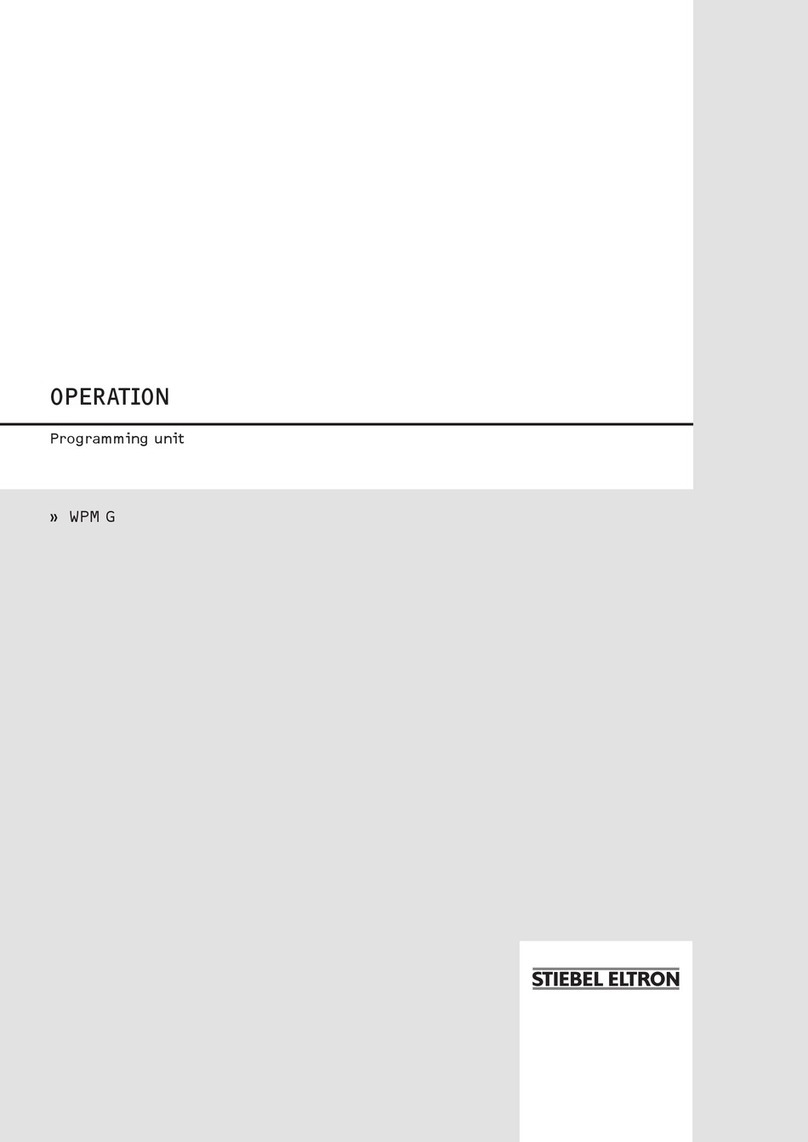
STIEBEL ELTRON
STIEBEL ELTRON WPM G Operation
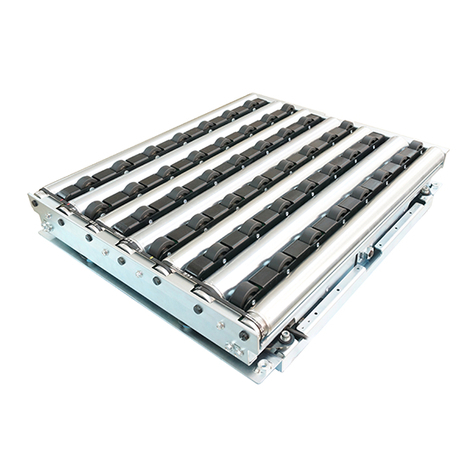
ITOH DENKI
ITOH DENKI F-RAT-NX75 user manual
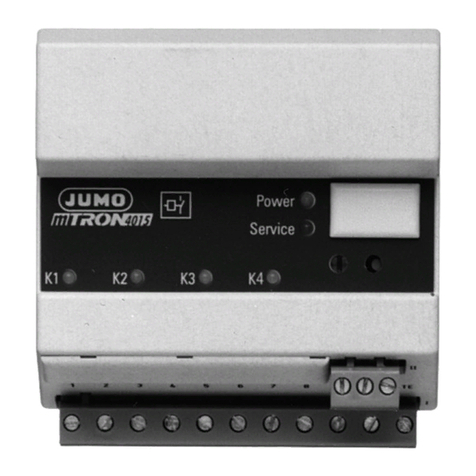
JUMO
JUMO mTRON B 70.4015.4 installation instructions

Pentair
Pentair HYPRO PROSTOP-E Installation and operation manual
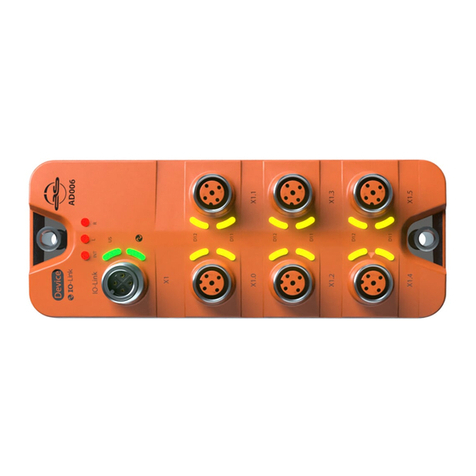
autosen
autosen AD006 operating instructions
